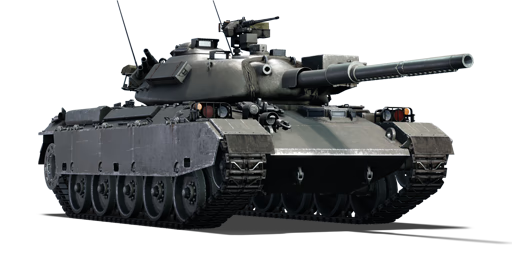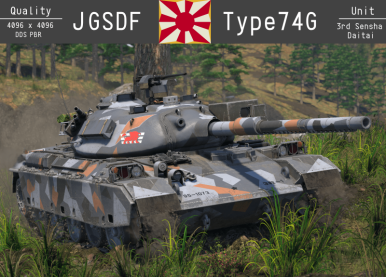



The Type 74 (G) (74式戦車G型) was a service life extension program for the Type 74 initiated in 1993 to keep it in service alongside the newer Type 90 MBT. The program involved adding a passive infrared camera, side skirts, and new electronics to the tank, as well as adjusting the rear driving wheel to prevent track detachment. Although four Type 74 (G) tanks were tested and produced satisfactory results, the cost of upgrading all Type 74s was estimated at 100 million yen. As a result, only five Type 74s were upgraded. Eventually, the Type 74s were replaced by the Type 16 MCV.
It was introduced in Update 1.87 "Locked On" as a premium pack but was removed from the Gaijin store after the 2022 "Winter sale". It was made available temporarily for purchase in-game with Golden Eagles during the 2023 "National Foundation Day in Japan" mini-event and then returned permanently as a premium vehicle during the 2024 one.
Compared to its tech tree counterparts, the Type 74 (E) and (F), it has the IR floodlight replaced by a thermal imaging system and a minuscule upgrade to its protection in the addition of side skirts.
| Ammunition | Type | Armor penetration (mm) at a distance: | |||||
|---|---|---|---|---|---|---|---|
| 10 m | 100 m | 500 m | 1000 m | 1500 m | 2000 m | ||
| HEATFS | 400 | 400 | 400 | 400 | 400 | 400 | |
| APFSDS | 292 | 291 | 284 | 275 | 266 | 257 | |
| Smoke | 3 | 3 | 3 | 3 | 3 | 3 | |
| APFSDS | 405 | 403 | 396 | 388 | 378 | 370 | |
| Belt | Belt filling | Armor penetration (mm) at a distance: | |||||
|---|---|---|---|---|---|---|---|
| 10 m | 100 m | 500 m | 1000 m | 1500 m | 2000 m | ||
| API-T/I/AP/API-T | 31 | 29 | 21 | 14 | 9 | 6 | |
| Belt | Belt filling | Armor penetration (mm) at a distance: | |||||
|---|---|---|---|---|---|---|---|
| 10 m | 100 m | 500 m | 1000 m | 1500 m | 2000 m | ||
| AP/AP/T | 13 | 12 | 7 | 3 | 2 | 0 | |







 2 x (145 / 190 / 225) %
2 x (145 / 190 / 225) % 
 2 x 214 %
2 x 214 % 

Mobility | |
|---|---|
Protection |
|---|
Firepower | ||
|---|---|---|
